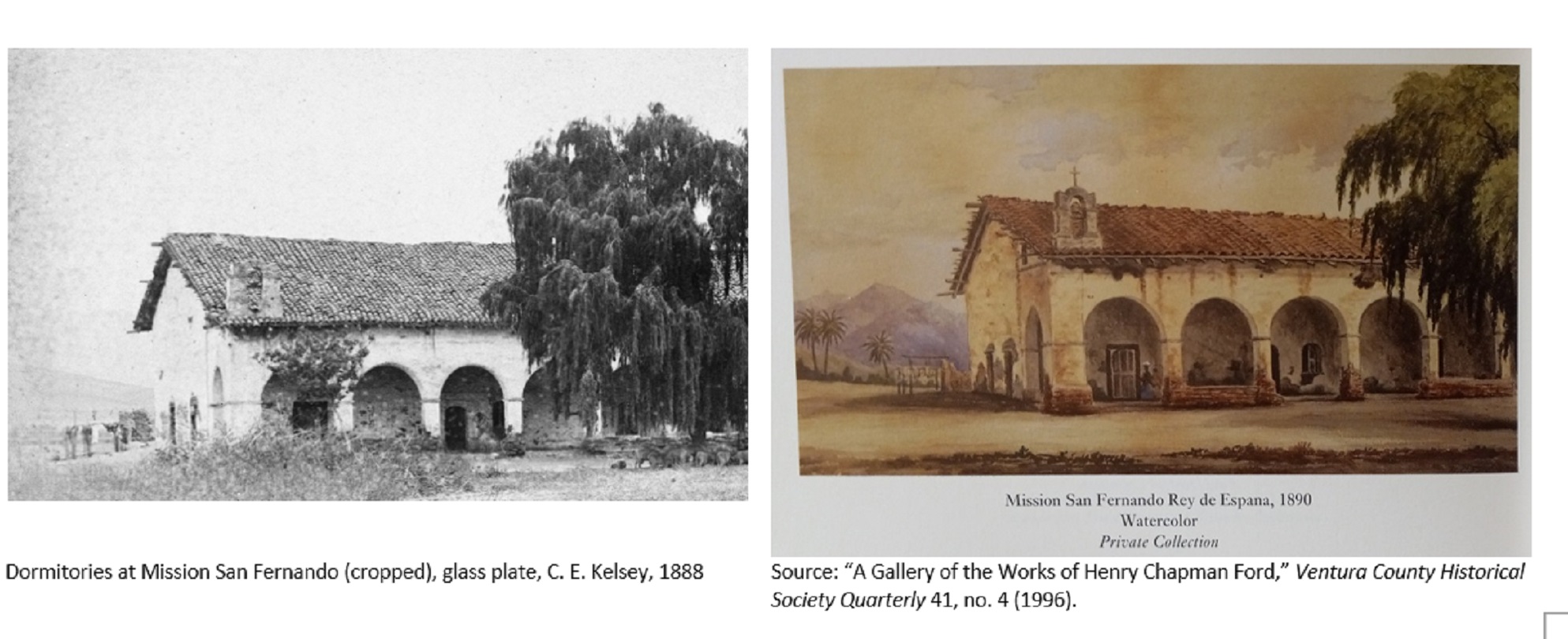According to his descendants, Kelsey was a photographer for Henry Chapman Ford and other artists touring California missions in 1888. Ford’s sketching excursions consisted of weeks or months of touring and camping. On the 1888 trip, Kelsey photographed the sites as the artists worked; the artists could finish their drawings and paintings later by referring to the photographs. Kelsey’s photos depict the missions at San Buenaventura, San Diego, San Fernando, San Gabriel, San Juan Capistrano, San Luis Rey, and Santa Barbara. A couple of them closely match later mission paintings by Ford.
One of Kelsey’s notebooks traces his trip from Santa Barbara starting May 14, 1888. Listing mission names, campsites, and other locations, it runs for about six weeks, ending precisely at 6:05 p.m. on July 2, when Kelsey returned to Santa Barbara and wrote “Finis 672 miles.” A notebook kept by Ford in 1888, described in Norman Neuerberg’s article “Henry Chapman Ford: Painter of Early California” (page 39), lists a similar itinerary, though I have not had a chance to view it to seek verification of the Kelsey-Ford connection. The Ford notebook is part of the Henry Chapman Ford Papers at the Autry National Center in Los Angeles.
Kelsey photographed sites other than missions on the tour. Notable among them is Rancho Camulos, where Helen Hunt Jackson’s best-selling novel Ramona (1884) purportedly took place. The Ford tour gave Kelsey a chance to relate those fictional characters and events to indigenous people. The published version of Ford’s 1888 notebook mentions the “Cohuilla Indians at San Jacinto” and the “Temécula Rancheria, Pauba.” Ford later described visiting “remnant Mission Indians” at Soboba and the San Diego Mission in 1888, per Ford’s An Artist Records the California Missions, edited by Neuerberg (page 94), so it is likely that Kelsey visited them too.
The tour was educational for Kelsey in more basic ways. Not only may he have had his first encounters with California Indians and their conditions, he also mastered the art of making biscuits thanks to the tour’s chuck wagon cook. Years later Kelsey’s daughter raved about the biscuits he always made for supper: “beautiful, light biscuits, like little pillows.”
Kelsey’s granddaughter thought that Ford and Kelsey met through artist Lemuel M. Wiles. Wiles and Kelsey’s father were natives of Perry (New York) who were related by marriage. Wiles traveled to California, where he painted some of the missions and may have spent time with both Ford and Kelsey’s brother Winfield. In 1880, Winfield was a painter living in Oakland; he later moved to Ventura, a town about 30 miles south of Ford’s studio in Santa Barbara, where he ran a newspaper.
Strengthening the web of possible relationships between the Kelsey family and Ford are Ford’s connections to Chicago. Ford lived and exhibited his work there from 1863 to 1875, just before he moved to California. Once established in California, he often went east, to Chicago and elsewhere, sometimes showing his paintings. Chicago was about 200 miles from the Kelsey home in Montello. As the major urban center for the upper Midwest, it is possible that the Kelseys periodically traveled to Chicago, where they could have met up with Ford. There are no family stories of this, however.
